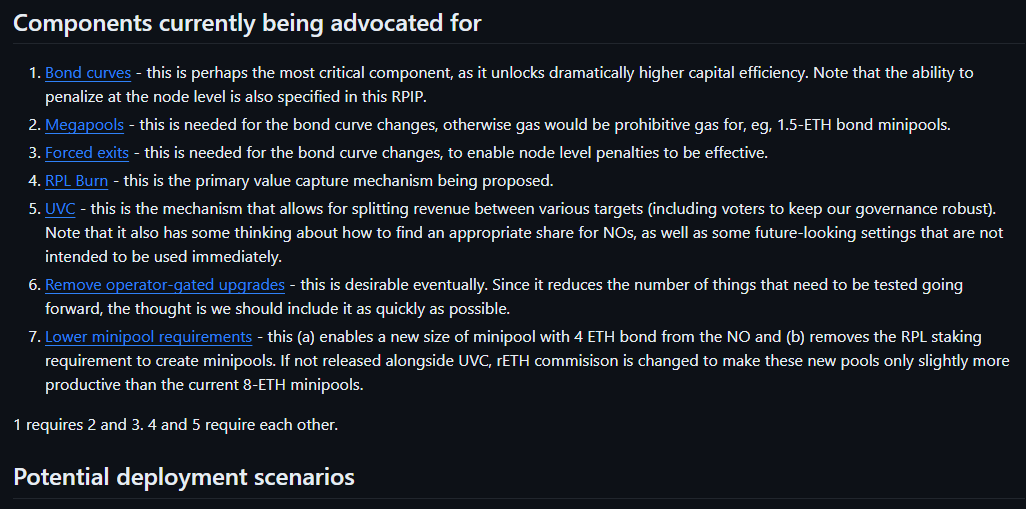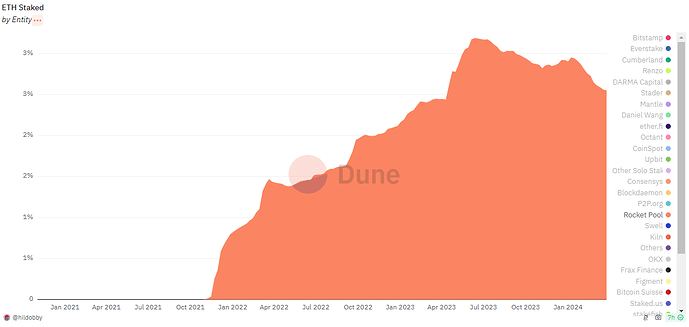Thanks for the thoughts @rocknet
I’ll respond to some particular bits…
We should allow another six months after the withdrawal threshold is set to 60% before making further RPL tokenomics changes, to see how the change plays out. This means I advocate not making dramatic RPL tokenomics changes for the remainder of 2024.
We are, essentially, a startup protocol. We are not yet getting enough revenue at this size to be stable imo. We have lost market share since last summer (some of the recent action has been the points meta etc). I think action is existential.
And then there’s competition. Lido CSM aims to launch late 2024. If we haven’t even started to move by the time that has already launched, I think there’s a good chance we simply cannot compete for Node Operators.
I think our brand is awesome. There’s a period of time we can use that to keep ourselves above water. I don’t think it’s indefinite and I think if we’re simply waiting the rest of 2024, then we might as well pack it in.
3.5 / 14 = 0.25 (25%, a 75% reduction)
This is not right. Currently, we pay 14% commission to an amalgam of both ETH and RPL staking. The only way to get 75% reduction is to assume that RPL burn has zero benefit to RPL holding NOs. There is a reduction insofar as more RPL is now being rewarded (all vs staked). I see this partly as a temporary thing, however – there’s no reason to expect large amounts of unstaked RPL long term.
Nodeset/Constellation
You discuss the NOs that benefit – absolutely, accepting free money is the easy part. RPL also shouldn’t be too hard – holders can get some yield instead of none. The tough part is finding enough ETH. xrETH yield is solo apr, or ~3.9%; this is lower than something like rETH/ETH LPing, currently 4.5-10% apr, and it uses younger less tested contracts. RPL also becomes a challenge at maturity. When growth isn’t a significant expectation and more than 70% of RPL is staked, rewards won’t even offset inflation and I’m not sure why anyone would hold it independent of personally running a minipool.
I hope I’m misunderstanding the market and there is a huge appetite here, but I don’t personally see it.
I believe one should consider whether some of the more dramatic changes below will even be necessary. Assume NodeSet / Constellation provides some level of scaling, and LEB4 with Megapools provides more. No one knows for sure how deep the rETH demand is
This might be an important perspective difference. If rETH demand is easily met because it isn’t deep, I consider RP a failed experiment. I think we need to see at least a 4x of our TVL to hit long term sustainability.
Prefer to scale with current Rocket Pool NOs, or those that have avoided Rocket Pool so far?
I am a little agnostic. All else being equal - sure, I love the community. But I think it’s primarily important to scale.
As a small side note… we could absorb ~95k more ETH if current NOs that already have enough RPL staked migrated to LEB8s. I’m not quite sure what to make of that fact, to be honest. I think some of it is simple awareness and inertia of the status quo. I think some might be liking a large buffer to continue receiving RPL rewards. The point I’m trying to make is that we’ve only had about 4.8k migrations and we could’ve had ~double that. If we keep the 10% borrowed ETH RPL bond, I suspect we do even worse at migrating to LEB4s (as the required RPL exposure of the smallest minipools would get more extreme from the current 30% to 70%).
So, the deposit pool draws down to some unknown extent, and no value accrues to the protocol token to help fund the DAO and team, due to the removed RPL stake.
I’d love to discuss this further. The whole point of the burn is market demand that benefits all RPL holders. Please see slides 13 and 14 in On The Horizon - Google Slides, which explicitly address how the token is benefitted by more ETH-only operators. Alongside the earlier “75% reduction” calculation, I am wondering if it’s simply the case that you believe that market buy+burn accrues no value. If that’s the case, do you feel any different about the buy+LP strategy?

